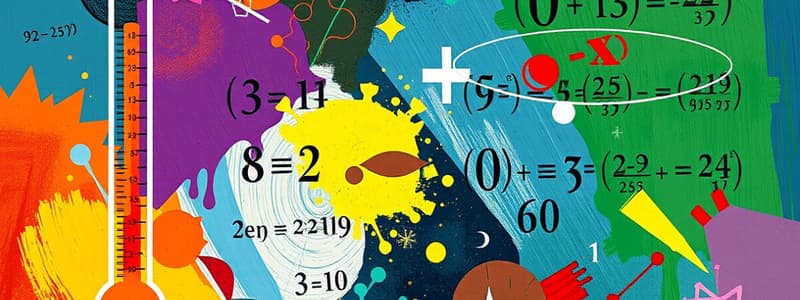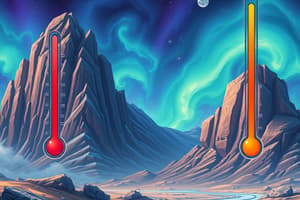Podcast
Questions and Answers
At what temperature do the numerical readings on a Celsius thermometer and a Fahrenheit thermometer equal each other?
At what temperature do the numerical readings on a Celsius thermometer and a Fahrenheit thermometer equal each other?
- 32 degrees
- 100 degrees
- 0 degrees
- -40 degrees (correct)
What is the mass of oil with a specific gravity of 0.7 if there are 325 ml of oil present?
What is the mass of oil with a specific gravity of 0.7 if there are 325 ml of oil present?
- 0.456 kg
- 0.650 kg
- 0.231 kg (correct)
- 0.910 kg
Which of the following is NOT a postulate of Dalton's Atomic Theory?
Which of the following is NOT a postulate of Dalton's Atomic Theory?
- Compounds are formed from atoms of different elements.
- Atoms can change into different elements. (correct)
- All atoms of an element have identical properties.
- Atoms are extremely small, indivisible particles.
What is the conversion of 3 angstroms to nanometers?
What is the conversion of 3 angstroms to nanometers?
What is the density of copper if its mass is determined to be $125$ grams and its volume is $14$ cm³?
What is the density of copper if its mass is determined to be $125$ grams and its volume is $14$ cm³?
Which scientist is considered the father of modern atomic theory?
Which scientist is considered the father of modern atomic theory?
How can compounds be formed according to Dalton's Atomic Theory?
How can compounds be formed according to Dalton's Atomic Theory?
What does the term 'atoms' refer to in the context of atomic theory?
What does the term 'atoms' refer to in the context of atomic theory?
What role does the strong nuclear force play in atomic nuclei?
What role does the strong nuclear force play in atomic nuclei?
Which statement best describes the neutron as discovered by James Chadwick?
Which statement best describes the neutron as discovered by James Chadwick?
In the Bohr model of the atom, how are electrons arranged around the nucleus?
In the Bohr model of the atom, how are electrons arranged around the nucleus?
What is the significance of the Schrödinger equation in quantum mechanics?
What is the significance of the Schrödinger equation in quantum mechanics?
Which of the following best describes the weak nuclear force?
Which of the following best describes the weak nuclear force?
How did James Chadwick confirm the presence of neutrons?
How did James Chadwick confirm the presence of neutrons?
What did the gold foil experiment demonstrate about atomic structure?
What did the gold foil experiment demonstrate about atomic structure?
What concept is illustrated by the planetary model proposed by Neils Bohr?
What concept is illustrated by the planetary model proposed by Neils Bohr?
According to the law of definite proportions, different samples of the same compound will have what characteristic?
According to the law of definite proportions, different samples of the same compound will have what characteristic?
What does the law of multiple proportions state about two elements that can form multiple compounds?
What does the law of multiple proportions state about two elements that can form multiple compounds?
Who is credited with the discovery of electrons?
Who is credited with the discovery of electrons?
What model of the atom did J.J. Thomson propose?
What model of the atom did J.J. Thomson propose?
What was a major conclusion from Ernest Rutherford's Gold Foil Experiment?
What was a major conclusion from Ernest Rutherford's Gold Foil Experiment?
What charge does a proton have compared to an electron?
What charge does a proton have compared to an electron?
In the context of atomic structure, what was determined about protons in relation to the nucleus?
In the context of atomic structure, what was determined about protons in relation to the nucleus?
Which of the following statements is true regarding the structure of an atom?
Which of the following statements is true regarding the structure of an atom?
What does the atomic number of an element represent?
What does the atomic number of an element represent?
Which of the following statements about isotopes is correct?
Which of the following statements about isotopes is correct?
What is the charge of a neutron?
What is the charge of a neutron?
When calculating the average atomic mass, which of the following factors is NOT considered?
When calculating the average atomic mass, which of the following factors is NOT considered?
What type of molecule is formed by combining more than two atoms?
What type of molecule is formed by combining more than two atoms?
Which term describes an atom or group of atoms that possesses a net positive charge?
Which term describes an atom or group of atoms that possesses a net positive charge?
What happens to the number of electrons in a neutral atom compared to the number of protons?
What happens to the number of electrons in a neutral atom compared to the number of protons?
Which of the following correctly defines a molecule?
Which of the following correctly defines a molecule?
Flashcards are hidden until you start studying
Study Notes
Atomic Theory
- Atoms are the fundamental building blocks of matter, originating from the Greek word "atomos," meaning indivisible.
- Democritus proposed that matter is composed of tiny, indivisible particles around 470 - 400 BC.
- John Dalton, known as the Father of Modern Atomic Theory, published his atomic theory in 1808, emphasizing the existence of atoms, their identical properties within elements, and the conservation of atoms during reactions.
Dalton's Atomic Theory
- Elements comprise very small, indivisible particles called atoms.
- Atoms of the same element have identical properties, differing from those of other elements.
- Atoms cannot be created or destroyed.
- Compounds arise from specific ratios of different atoms.
- The composition of compounds is consistent in relative proportions of atoms.
Relevant Laws
- Law of Definite Proportions (Joseph Proust): Same compound samples contain components in fixed proportions.
- Law of Multiple Proportions: When two elements form multiple compounds, the mass ratios of one combined with a fixed mass of the other are whole numbers.
Fundamental Particles
- Atoms consist of electrons, protons, and neutrons.
- J.J. Thomson discovered electrons in 1897 through cathode ray experiments and proposed the Plum-Pudding Model of the atom.
- Ernest Rutherford's Gold Foil Experiment (1911) revealed that:
- Atoms are mostly empty space.
- Most mass is concentrated in a dense, positively charged nucleus.
- Electrons orbit surrounding the nucleus.
Nuclear Structure
- Protons carry a positive charge; their mass is roughly 1840 times that of electrons.
- Protons remain within the nucleus due to a strong nuclear force, which also binds neutrons and protons together.
- Weak nuclear force governs processes like beta decay.
Atomic Models
- Neils Bohr introduced the Planetary Model in 1913, defining fixed electron orbits with quantized energy levels.
- Erwin Schrödinger developed the Quantum Model, describing electron behavior via wave functions, quantifying electron energy levels through the Schrödinger equation.
Discovery of Neutrons
- James Chadwick discovered neutrons in 1932, showing they are electrically neutral and of similar mass to protons.
Atomic Number and Mass
- Atomic Number: Number of protons in an atom's nucleus.
- Mass Number: Total count of protons and neutrons; in neutral atoms, protons equal electrons.
- Isotopes are variations of elements with the same protons but different neutrons, yielding diverse atomic masses.
Molecules
- Molecules are the smallest units of compounds that retain stable properties.
- Can be diatomic (two atoms) or polyatomic (more than two atoms).
Ions
- Ions are atoms or groups with a net charge.
- Types of Ions:
- Cations: Positive net charge.
- Anions: Negative net charge.
Studying That Suits You
Use AI to generate personalized quizzes and flashcards to suit your learning preferences.




